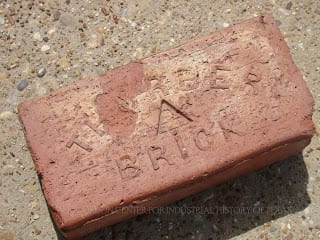B, T, AND T

by David Buster
Arithmetic! Algebra! Geometry! Grandiose trinity! Luminous triangle! Whoever has not known you is without sense!
~ Comte de Lautréamont
After reading this quote, I have decided that Lautréamont would have a field day with me. Surely, the nineteenth century Uruguayan-born French poet would mark me as an idiot. After all, some 139 years after his death I found myself befuddled by a simple triangle, but not in the mathematical sense. No, the triangle that stumped me did not involve the Pythagorean Theorem. Heck, it did not even involve the Holy Trinity, did not embrace some sinful tryst with a forbidden lover, or a renowned basketball offense. The triangle that perplexed me was a symbol on the front of a brick containing the letters B, T, and T inside each corner.

Thankfully I was not alone in this confusion. As I have discovered, there are many others who faced this same quandary. Currently, I work as a graduate assistant at the W.K. Gordon Center. Thurber became known for two major industries during its heyday: coal mining and brick manufacturing. Throughout the course of any particular day, museum patrons will ask an assortment questions, the most common being “What does the triangle on the brick mean?” Ah! The triangle. I can hear Lautréamont scoffing at me from his grave.
But, before one can truly understand “the triangle,” he or she needs to know how the bricks bearing it came about. In 1897 Richard D. Hunter, organizer of the Texas Pacific Coal Company, was visited by business associates James Green and L.M. Rumsey of St. Louis, Missouri. During their visit, Green and Rumsey became interested in the shale deposits located in the Thurber vicinity. Green, the owner of the Laclede Fire Clay Works, thought that the earth would be suitable for brick making and sent samples to St. Louis to be analyzed.

The tests demonstrated that the material would be suitable for the manufacturing of drain pipes, roof and floor tile, pressed and vitrified brick. The results of these initial tests prompted Hunter and others to join with Green and Hunter in constructing a brick plant at Thurber. It opened in summer 1897 as one of the most modern facilities west of the Mississippi.
So how does the triangle labeled B, T, and T factor into this? In 1903 organized labor finally managed to squeeze its way into Thurber. A successful strike on September 10, 1903 caused the mines in Thurber to idle. With the mines not producing any fuel, the brick plant would have to suspend production.
In order to end this strike, company Vice President Edgar L. Marston, met the requests of the striking miners and recognized their newly formed local of the United Mine Workers of America. At the same time, the operators agreed to recognize other craft unions representing their areas of work. Thurber in time became reputedly the only entirely unionized city in the United States. After the strike, the employees of the brick plant formed the Brickmakers’ Union of Thurber, Local 153. This union, a part of the now defunct American Federation of Labor, stamped a triangle onto all bricks produced at Thurber as a union made label.

Now that the origin of the triangle is known, where do the initials B, T, and T come into play? In 1908 the union chose a new name, the Brick, Tile and Terra Cotta Workers Alliance. This would become the source of the initials of B, T, and T that are found on Thurber bricks.
Also it appears that the triangular stamp was used elsewhere. Through research inquiries, photographs have turned up showing bricks in California and several union pins employing the same symbol. So, now my journey has come full circle. At the end of the day, I have finally unraveled the meaning of the BTT triangle. Who knows, Comte de Lautréamont may be proud of me after all.